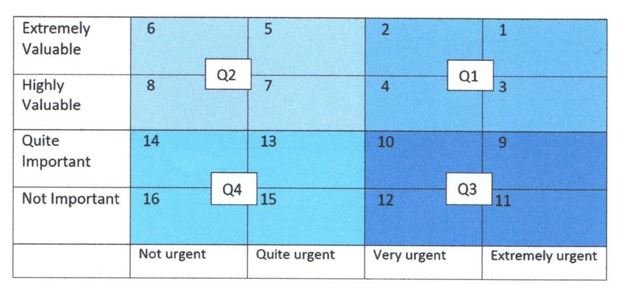How to Manage a Crisis
How to Manage a Crisis
In order to manage a crisis the most important thing is to do prioritise tasks into the right order.
Every task can be judged against two fundamental criteria:
- The value of the task. (Its importance).
- The time deadline pressure. (Its urgency).
We can subdivide both categories into:
Value (Importance).
1. Extremely valuable
2. Highly valuable
3. Quite important
4. Not important.
Deadline pressure (Urgency)
1. Extremely urgent
2. Very urgent
3. Quite urgent
4. Not urgent.
You prioritise your tasks by comparing each of them against the two criteria of "value" and "deadline pressure", using the word descriptions above.
Then you assign a number to each task according to the grid below.

Simply by plotting the tasks onto the grid, the most logical order will make itself apparent.
If circumstance allow, you should do the tasks in the order given by the grid.
What is the standard of value?
You need to be fully conscious about what index you are using to determine "value".
When you are judging value, you can be standing in one of three positions:
- What is valuable for yourself (self interest)?
- What is valuable for others (selflessness - altruistic)?
- What is valuable for the system as a whole (social - systems thinking)?
In any decision-making situation, you should consciously decide, from which base you are making the decision.
Sometimes it is okay to be selfish. Other times, it is NOT okay.
Theory vs practice.
In practice you will not be able to do things exactly in the order indicated by the theory, because you may not have the resources, the people, or the money to do them.
The above grid serves to give you an idealised plan, which you should use to guide your thinking.
In every case, you use the "ideal" as a your best "guide to intelligent action".
WhatsNext? - Free Priority Order App
Corporate Coach have developed a fantastic Prioritisation App, which is based on the above method.
To manage your time by prioritising your tasks, please take advantage of our Prioritisation App.
Definition: Urgent-Important Grid
In business crises, the urgent-important grid is a simple decision tool. It scores each task on value and deadline, puts the scores into four boxes, highlights the jobs that give the most gain in the least time, and keeps scarce effort away from low-value, no-rush work.
Show CG4D Definition
- Scores every task on two points: value and deadline
- Builds a four-box chart from those two scores
- Ranks tasks so high-value, tight-deadline jobs lead the list
- Loses accuracy if tasks are not placed and checked before action
Article Summary
In any crisis, keep control by ranking each task on two clear points: its value and its deadline. Plot jobs on an urgent-important grid, act first on high-value tasks with tight times, delay low-value, no-rush ones, and use a free digital tool to keep the list visible for all. This simple process turns panic into planned action.
Frequently Asked Questions
Here are some questions that frequently get asked about this topic during our training sessions.
How do I start to manage a crisis when many tasks look urgent?
What is an urgency–importance matrix?
How do I judge the value of a task?
Why is deadline pressure a key factor in task choice?
Should I ever act on low-value tasks first?
What happens if I lack resources for the ideal order?
How often should I review the grid during a crisis?
Thought of something that's not been answered?
Did You Know: Key Statistics
PwC 2023 survey shows 96% of firms faced at least one crisis in the last two years, yet only 35% had a formal response plan. Asana 2024 work report finds staff spend 33% of each day on low-value work caused by poor task order.Blogs by Email
Do you want to receive an email whenever we post a new blog? The blogs contain article 5-10 minutes long - ideal for reading during your coffee break!
Further Reading in Leadership and Management
-
Great Leaders
Discover how leadership skills are learned, not inherited, and follow simple steps to build vision, confidence and action so you can lead with purpose.
Read Article > -
Intelligence - From Data to Wisdom
Learn the Data to Wisdom model that lifts data to information, knowledge, understanding and wisdom. Gain clear steps, real examples and ethical tips for sharp leadership.
Read Article > -
If the Success Formula is so Simple, Why Isn't Everyone Doing It?
Learn the five-step success formula to set goals, act, use feedback and embrace change. Beat fear of failure, handle criticism and reach lasting results.
Read Article > -
Managing Imposter Syndrome
Learn practical ways for managing imposter syndrome, restore self-belief and align inner feelings with action to turn self-doubt into steady confidence.
Read Article > -
Mastermind Alliance
Learn how a mastermind alliance of two to seven people with mixed skills boosts team creativity, speeds problem solving and drives better results at work.
Read Article >
Looking for Leadership and Management Training?
If you're looking to develop your Leadership and Management Skills, you may find this Leadership and Management Training Course beneficial:
Open Training Course Pricing and Availability
Next Open Course Starts in 4 days, Cambridge , places available






